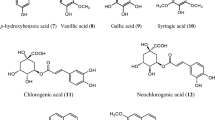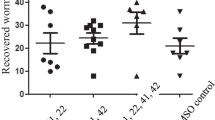Abstract
The present study reports on the antifilarial activity of a marine sponge Haliclona exigua (phylum Porifera). The crude methanol extract and n-butanol-soluble fraction killed adult Brugia malayi at 31.25-μg/ml concentration (both in motility and 3-(4,5 dimethylthiazol-2-yl)-2,5 diphenyl tetrazolium bromide assay) while the chloroform fraction was lethal at a lower concentration of 15.6 μg/ml. The activity could be located in a single molecule araguspongin C which brought about mortality of worm at 15.6 μg/ml. In vivo evaluation of the crude extract (5 × 500 mg/kg, orally) and the chloroform fraction (5 × 250 mg/kg, orally) in B. malayi-infected rodent host, Mastomys coucha, did not show any significant microfilaricidal actions; however, microfilarial densities in both the treated groups were significantly much lower than those of untreated group in contrast to standard filaricide diethylcarbamazine which exerted 79% microfilaricidal action on day 8 of treatment. Both these extracts also demonstrated adulticidal (macrofilaricidal) activity which was more pronounced in the chloroform fraction (50.2%). In addition, there was moderate adverse effect on the reproductive potential of female worms (crude extract 46.5%; chloroform 58.6%). The findings suggest that the marine sponge H. exigua possesses adulticidal and embryostatic action against human lymphatic filarial parasite B. malayi in experimental rodent model and this activity could be attributed to the presence of araguspongin C.

Similar content being viewed by others
References
Bajpai P, Vedi S, Owais M, Sharma SK, Saxena PN, Misra-Bhattacharya S (2005a) Use of liposomized tetracycline in elimination of Wolbachia endobacterium of human lymphatic filariid Brugia malayi in a rodent model. J Drug Target 13(6):375–381
Bajpai P, Verma SK, Katiyar D, Tewari N, Tripathi RP, Bansal I, Saxena JK, Misra-Bhattacharya S (2005b) Search for new prototypes for the chemotherapy of filariasis: a chemotherapeutic and biochemical approach. Parasitol Res 95:383–390
Bajpai P, Srivastava K, Shakya S, Saxena PN, Misra-Bhattacharya S (2007) Improvement in the efficacy of existing combination of antifilarials by inclusion of tetracycline in rodent model of brugian filariasis. Curr Sci 92(5):655–658
Bhosale SH, Jagtap TG, Naik CG (1999) Antifungal activity of some marine organisms from India, against food spoilage Aspergillus strains. Mycopathologia 147:133–138
Dube A, Singh N, Saxena A, Lakshmi V (2007) Antileishmanial potential of a marine sponge Haliclona exigua (Kirkpatrick) against experimental visceral leishmaniasis. Parasitol Res 101(2):317–324
Faulkner DJ (2001) Marine natural products. Nat Prod Rep 18:1–49
Fournet A, Munoz V (2002) Natural products as trypanocidal antileishmanial and antimalarial drugs. Curr Top Med Chem 2:1215–1237
Haefner B (2003) Drugs from the deep marine natural products as drug candidates. Drug Discov Today 8:536–544
Kayser O, Kiderlen A, Croft S (2003) Natural products as antiparasitic drugs. Parasitol Res 90:S55–S62
Lakshmi V, Saxena A, Pandey K, Bajpai P, Misra-Bhattacharya S (2004a) Antifilarial activity of Zoanthus species (Phylum Coelenterata Class Anthozoa) against human lymphatic filaria Brugia malayi. Parasitol Res 93:268–273
Lakshmi V, Kumar R, Gupta P, Varshney V, Srivastava MN, Dikshit M, Murthy PK, Misra-Bhattacharya S (2004b) The antifilarial activity of a marine red alga Botryocladia leptopoda against experimental infections with animal and human filariae. Parasitol Res 93:468–474
McCall JW, Malove JB, Ah H, Thompson PE (1973) Mongolian jirds (Meriones unguiculatus) infected with Brugia malayi by the intraperitoneal route. A rich source of developing larvae adult filariae and microfilariae. J Parasitol 59:436
Misra S, Chatterjee RK, Sen AB (1984) The response of Litomosoides carinii to antifilarial agents in cotton rat Sigmodon hispidus and multimammate rat (Mastomys natalensis). Indian J Med Res 7:749–752
Misra-Bhattacharya S, Katiyar D, Bajpai P, Tripathi RP, Saxena JK (2004) 4-Methyl-7-(tetradecanoyl)-2H-1-benzopyran-2-one a novel DNA topoisomerase II inhibitor with adulticidal and embryostatic activity against sub-periodic Brugia malayi. Parasitol Res 92:177–182
Mukherjee M, Misra S, Chatterjee RK (1998) Development of in vitro screening system for assessment of antifilarial activity of compounds. Acta Tropica 70:251–255
Nakao Y, Shiroiwa T, Murayama S, Matsunaga S, Goto Y, Matsumoto Y, Fusetani N (2004) Identification of renieramycin A as an antileishmanial substance in a marine sponge Neopetrosia sp. Marine Drugs 2:55–62
Ottesen EA (2000) The global programme to eliminate lymphatic filariasis. Trop Med Int Health 5:591–594
Owais M, Misra-Bhattacharya S, Haq W, Gupta CM (2003) Immunomodulator tuftsin augments antifilarial activity of diethylcarbamazine against experimental Brugian filariasis. J Drug Target 11(4):247–251
Rangel HR, Dagger F (1997) Antiproliferative effect of illimaquinone on Leishmania mexicana. Cell Biol Int 21:337–339
Rao KV, Santarsiero BD, Mesecar AD, Schinazi RF, Tekwani BL, Hamann MT (2003) New manzamine alkaloids with activity against infectious and tropical parasitic diseases from an Indonesian sponge. J Nat Prod 66:823–828
Rao KV, Kasanah N, Wahyuono S, Tekwani BL, Schinazi RF, Hamann MT (2004) Three new manzamine alkaloids from a common Indonesian sponge and their activity against infectious and tropical parasitic diseases. J Nat Prod 67:1314–1318
Rao KV, Donia MS, Peng J, Garcia-Palomero E, Alonso D, Martinez A, Medina M, Franzblau SG, Tekwani BL, Khan SI, Wahyuono S, Willett KL, Hamann MT (2006) Manzamine B and E and ircinal A related alkaloids from an Indonesian Acanthostrongylophora sponge and their activity against infectious, tropical parasitic and Alzheimer’s diseases. J Nat Prod 69(7):1034–1040
Reddy MVR, Faulkner DJ (1997) 3β,3′β-Dimethylxestospongin C, a new bis-1-oxaquinolizidine alkaloid from the Palauan sponge Xestospongia sp. Nat Prod Lett 11:53–59
Sänger I, Lämmler G, Kimming P (1981) Filarial infections of Mastomys natalensis and their relevance for experimental chemotherapy. Acta Trop 38:277–288
Schares G, Hofmann B, Zahner H (1994) Antifilarial activity of macrocyclic lactones: comparative studies with ivermectin, doramectin, milbemycin A4 oxime, and moxidectin in Litomosoides carinii, Acanthocheilonema viteae, Brugia malayi, and B. pahangi infection of Mastomys coucha. Trop Med Parasitol 45(2):97–106
Shakya S, Bajpai P, Sharma S, Misra-Bhattacharya S (2008) Prior killing of intracellular bacteria Wolbachia reduces inflammatory reactions and improves antifilarial efficacy of diethylcarbamazine in rodent model of Brugia malayi. Parasitol Res 102:963–972
Venkateshwarlu Y, Reddy MVR, Rao JV (1994) Bis-1-oxaquinolizidine from the sponge Haliclona exigua. J Nat Prod 57:1283–1285
Yan HY (2004) Harvesting drugs from the seas and how Taiwan could contribute to this effort. Changhua J Med 9:1–6
Zahner H, Striebel HP, Schütze HR, Sänger I, Müller HA, Schultheiss K (1988) Antifilarial activities of benzazole derivatives. 1. Macrofilaricidal effects against Litomosoides carinii, Dipetalonema viteae, Brugia malayi, and B. pahangi in Mastomys natalensis. Trop Med Parasitol 39(1):14–18
Zahner H, Taubert A, Harder A, von Samson-Himmelstjerna G (2001a) Effects of Bay 44-4400, a new cyclodepsipeptide, on developing stages of filariae (Acanthocheilonema viteae, Brugia malayi, Litomosoides sigmodontis) in the rodent Mastomys coucha. Acta Trop 80(1):19–28
Zahner H, Taubert A, Harder A, von Samson-Himmelstjerna G (2001b) Filaricidal efficacy of anthelmintically active cyclodepsipeptides. Int J Parasitol 31(13):1515–1522
Acknowledgments
The work was supported by the Department of Ocean Development, New Delhi, India. We thank Director, CDRI for encouragement and support and to Mr. H. R. Mishra, N. P. Mishra, A. K. Roy, and R. N. Lal for technical assistance. The financial assistance in the form of fellowship by the Council of Scientific and Industrial Research (SM) is gratefully acknowledged. This manuscript bears CDRI communication no. 7797.
Author information
Authors and Affiliations
Corresponding author
Rights and permissions
About this article
Cite this article
Lakshmi, V., Srivastava, S., Kumar Mishra, S. et al. In vitro and in vivo antifilarial potential of marine sponge, Haliclona exigua (Kirkpatrick), against human lymphatic filarial parasite Brugia malayi . Parasitol Res 105, 1295–1301 (2009). https://doi.org/10.1007/s00436-009-1555-1
Received:
Accepted:
Published:
Issue Date:
DOI: https://doi.org/10.1007/s00436-009-1555-1




